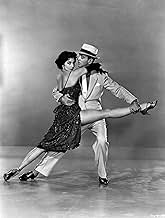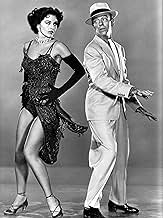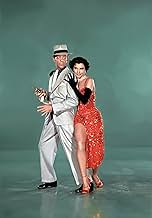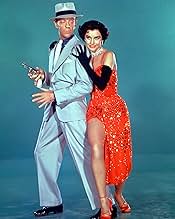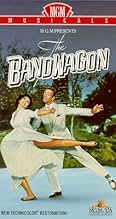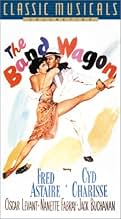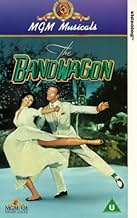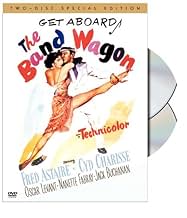CALIFICACIÓN DE IMDb
7.4/10
13 k
TU CALIFICACIÓN
Un pretencioso director artístico es contratado para dirigir un nuevo musical de Broadway, el cual transforma hasta hacerlo irreconocible.Un pretencioso director artístico es contratado para dirigir un nuevo musical de Broadway, el cual transforma hasta hacerlo irreconocible.Un pretencioso director artístico es contratado para dirigir un nuevo musical de Broadway, el cual transforma hasta hacerlo irreconocible.
- Dirección
- Guionistas
- Elenco
- Nominado a 3 premios Óscar
- 2 premios ganados y 5 nominaciones en total
India Adams
- Gabrielle Gerard
- (doblaje en canto)
- (sin créditos)
Fred Aldrich
- Hot Dog Vendor
- (sin créditos)
Richard Alexander
- Stagehand
- (sin créditos)
Ernest Anderson
- Train Porter
- (sin créditos)
Barbara Bailey
- Dancer
- (sin créditos)
Patsy Bangs
- Dancer
- (sin créditos)
Lysa Baugher
- Dancer in Troupe
- (sin créditos)
Mary Bayless
- Theatre Patron
- (sin créditos)
Brandon Beach
- Auction Guest
- (sin créditos)
Ralph Beaumont
- Dancer in Troupe
- (sin créditos)
Don Beddoe
- Producer
- (sin créditos)
Opiniones destacadas
Director Vincente Minnelli is probably the most important star of the visually stunning film "The Bandwagon". Betty Comden and Adolph Green supplied the book and most of the songs, aided by Arthur Schwartz and Alan Jay Lerner. And the relationships, as anyone who has worked in theater can attest, are unusually understated and true. The primary story-line concerns Tony Hunter, a man who has had failures in film and has now returned to Broadway looking for a good project. His old friend portrayed by Nanette Fabray and Oscar Levant have a project in mind. But they make the mistake of hiring an ambitious director who sees in their tale a vehicle for a Faustian allegory filled with deep meanings, fire, brimstone, explosions and necrophiliac lighting. Of course the musical they produce is a total failure; and Tony has been compelled to dance with a hired ballerina, with whom he finds himself falling hopelessly in love. In desperation, he suggests they go back to the original show and not disband. As a result they craft a success, Tony gets his girl and everything ends happily. This I find to be a first-rate MGM production, using its top personnel: cinematography by Henry Jackson, art direction by Preston Ames and Cedric Gibbons, sets by Edwin Willis and Keogh Gleason, Sydney Guilaroff's hairstyles and William Tuttle's makeup, and costumes by Mary Ann Nyberg. The stars of the film are all very professional and likable. Fred Astaire is Tony, Cyd Charisse the ballerina, Nanette Fabray andOscar Levant as ilmic Comden and Green stand-ins, Jack Gardner, James Mitchell, Robert Gist, and many others in small or uncredited roles including familiar faces such as Herb Vigran, Barbara Ruick, Julie Newmar, et al. Some have complained that the musical numbers here seemed a bit static or curiously cold; but this is a musical for once where the numbers look as if they could have been musical numbers onstage; and after chasing this film for decades, when I saw it I was delighted by its stunning visual qualities; and as a theatrical veteran I was also gratified that its human relationships seemed to work, as theatrical portraits by Comden and Green and in the personages who people this very enjoyable entertainment.
The Bandwagon may yet prove to be the best of backstage musicals. It certainly is Fred Astaire at his best, probably his best film when he did not partner with Ginger Rogers.
Arthur Freed had great success with two previous song catalog musicals, An American In Paris with the music of George Gershwin and Singing in the Rain which utilized the songs that he wrote with Nacio Herb Brown. His source for this film were the songs of Howard Dietz and Arthur Schwartz.
Dietz and Schwartz were an interesting pair of writers. Howard Dietz worked right at MGM in their publicity department. In fact it was Dietz who invented MGM's famous Leo the Lion. Song lyrics were in fact an avocation. Arthur Schwartz was a lawyer who just one day gave up the practice of law to devote himself to songwriting. They wrote some of the best music of the Thirties. After which Dietz devoted himself to publicizing MGM and Schwartz worked with other lyricists.
They wrote revues and this is where the source material for The Band Wagon comes from. In fact one of their revues was entitled The Band Wagon and starred none other than Fred and Adele Astaire. However the team got together again and wrote one new number for the film, the legendary That's Entertainment.
This The Band Wagon is not a revue. The plot concerns an aging musical film star Fred Astaire, talked into coming east by husband and wife writing team Nanette Fabray and Oscar Levant. They want him to do a Broadway show to revive his career. They get Broadway wunderkind Jack Buchanan to direct it and later on classical ballet star Cyd Charisse to team with Astaire.
Buchanan is outrageously funny as he first tries to get them to do an avant garde musical about the Faust saga. When that flops, he's a good enough trooper to put ego aside and do some serious rewriting. And this man certainly has one Texas size ego. According to a book on the Arthur Freed musicals, Buchanan was in a lot of pain from arthritis and doing some of those numbers, especially Triplets was agony for him.
That was not the only problem on the set. It was a pretty grim place. Oscar Levant had suffered a heart attack before the production and he was ten times his normal hypochondriac self. And Fred Astaire's wife was terminally ill at home.
Cyd Charisse gauging the mood of her fellow cast members just kept to herself, but Nanette Fabray who is an exuberant personality did not go over well as Miss Perky. She recorded it was one of her worst film experiences.
Still this monumental triumph of a film got made. My favorite of all the numbers besides That's Entertainment is the soft shoe duet that Fred Astaire and Jack Buchanan partner in. It's all grace and elegance and so typically Fred Astaire. And it's probably what most people know of Jack Buchanan. Over in the United Kingdom he was a leading stage and screen performer. Until The Band Wagon was made he was probably best known to American audiences as Jeanette MacDonald's leading man in Monte Carlo.
Cyd Charisse dances divinely as she always does, never better than in the finale, The Girl Hunt Ballet with Astaire. I still wonder why she never starred at MGM with her husband Tony Martin.
When one is asked what the American musical film ideal is, one of the best answers you can give is The Band Wagon.
Arthur Freed had great success with two previous song catalog musicals, An American In Paris with the music of George Gershwin and Singing in the Rain which utilized the songs that he wrote with Nacio Herb Brown. His source for this film were the songs of Howard Dietz and Arthur Schwartz.
Dietz and Schwartz were an interesting pair of writers. Howard Dietz worked right at MGM in their publicity department. In fact it was Dietz who invented MGM's famous Leo the Lion. Song lyrics were in fact an avocation. Arthur Schwartz was a lawyer who just one day gave up the practice of law to devote himself to songwriting. They wrote some of the best music of the Thirties. After which Dietz devoted himself to publicizing MGM and Schwartz worked with other lyricists.
They wrote revues and this is where the source material for The Band Wagon comes from. In fact one of their revues was entitled The Band Wagon and starred none other than Fred and Adele Astaire. However the team got together again and wrote one new number for the film, the legendary That's Entertainment.
This The Band Wagon is not a revue. The plot concerns an aging musical film star Fred Astaire, talked into coming east by husband and wife writing team Nanette Fabray and Oscar Levant. They want him to do a Broadway show to revive his career. They get Broadway wunderkind Jack Buchanan to direct it and later on classical ballet star Cyd Charisse to team with Astaire.
Buchanan is outrageously funny as he first tries to get them to do an avant garde musical about the Faust saga. When that flops, he's a good enough trooper to put ego aside and do some serious rewriting. And this man certainly has one Texas size ego. According to a book on the Arthur Freed musicals, Buchanan was in a lot of pain from arthritis and doing some of those numbers, especially Triplets was agony for him.
That was not the only problem on the set. It was a pretty grim place. Oscar Levant had suffered a heart attack before the production and he was ten times his normal hypochondriac self. And Fred Astaire's wife was terminally ill at home.
Cyd Charisse gauging the mood of her fellow cast members just kept to herself, but Nanette Fabray who is an exuberant personality did not go over well as Miss Perky. She recorded it was one of her worst film experiences.
Still this monumental triumph of a film got made. My favorite of all the numbers besides That's Entertainment is the soft shoe duet that Fred Astaire and Jack Buchanan partner in. It's all grace and elegance and so typically Fred Astaire. And it's probably what most people know of Jack Buchanan. Over in the United Kingdom he was a leading stage and screen performer. Until The Band Wagon was made he was probably best known to American audiences as Jeanette MacDonald's leading man in Monte Carlo.
Cyd Charisse dances divinely as she always does, never better than in the finale, The Girl Hunt Ballet with Astaire. I still wonder why she never starred at MGM with her husband Tony Martin.
When one is asked what the American musical film ideal is, one of the best answers you can give is The Band Wagon.
THE BAND WAGON tells the story of faded movie star Tony Hunter (Fred Astaire) as he attempts to restart his stage career with the help of his two pals Lester (Oscar Levant) and Lily (Nanette Fabray) Marton. The Martons have written Tony a surefire hit... or so they think, until they fall under the charms of writer/director/producer/actor du jour, Jeffrey Cordova (Jack Buchanan) and their lighthearted musical comedy is turned into some kind of freaky Faustian opera. Jeffrey also ropes the famous French ballet-dancer Gabrielle Gerard (Cyd Charisse) and her choreographer boyfriend Paul Byrd (James Mitchell) into the production, but Tony and Gabrielle start off with each other on the wrong foot--almost literally so, since Tony is primarily a hoofer feeling his age, and Gabrielle a ballet star in her prime. They don't seem to match at all, from age to temperament, right down to dancing style. When Tony and Gabrielle finally come to an understanding, however, it's evident their musical is headed for a critical drubbing, and their hint of a romantic relationship thrown into doubt by Paul's annoyance that Gaby doesn't want to leave the show with him. The rest of the film works at resolving this double impasse.
It's probably hard to avoid comparing this film to SINGIN' IN THE RAIN, since they were made just a year apart and were both written by Betty Comden and Adolph Green. Moreover, the themes are even vaguely similar--THE BAND WAGON is a gentle, sharp satire on theatrical goings-on; SINGIN' IN THE RAIN a wicked parody of Hollywood and movie-making. Both films list Cyd Charisse as one of the characters; both films have a ballet section towards the end of the film. And of course, both films star (separately, unfortunately) the two greatest dancing talents of any and every Hollywood generation--Fred Astaire (TBW) and Gene Kelly (SITR). So certainly, comparisons are rife... the films seem to *beg* one to make them! Personally, the chips fall on the side of SITR for me: it's got a tighter story line, it's less talky, the chemistry between the leads is impeccable, and the songs and dances are simply wonderful.
That is, however, an entirely personal preference. There are people--there are in fact several other IMDB reviewers--who prefer THE BAND WAGON, and with good reason. Entirely on its own merits and not in comparison to SITR (as it should be judged), this film is exactly what it sets out to be: a cracking two hours worth of sheer entertainment. It's cleverly written, while the songs and dances are charming and some even mind-blowing. Vincente Minelli does an excellent job of directing; he is, after all, justly known as the master of musical films. Astaire couldn't be bad if he tried, and he's quite ably supported by his cast of Charisse, Levant, Fabray and Buchanan. The numbers range from the heartbreakingly romantic and simple (Charisse and Astaire falling in love to 'Dancing In The Dark'); through to the clever and amusing (most of the brief numbers attributed to 'The Band Wagon', the play within the movie, but most especially the 'Triplets' number with Astaire, Fabray and Buchanan); on to the rousing and hilarious (Astaire's German accent midway through 'I Love Louisa); and finally to those that are simply stunning in their sheer technical mastery (without a doubt the 'Girl Hunt' ballet). And of course, that's forgetting to mention the song that best sums up the entire spirit of THE BAND WAGON: 'That's Entertainment!'. Joyously performed by Astaire, Fabray, Buchanan and Levant (and in a finale reprisal also featuring Charisse), you really get the feeling that *this* is what Hollywood, and more specifically, the MGM musical, is about. And at the game of entertainment, THE BAND WAGON succeeds handsomely.
I think the only problem I have with THE BAND WAGON is that it just doesn't come together as perfectly and as seamlessly as I'd like. There are moments when my attention drifts, and the acting is frequently uneven. (An exception would be Fabray, who simply radiates exuberance with her big voice and great moves in relatively little screen time.) I've said that Astaire couldn't be bad if he tried. True, he *isn't* bad... just a little listless, it seems to me, particularly in the first half of the film. His dancing, however, is faultless as usual, just as you'd expect from Astaire. And he definitely seems to warm up considerably in the second half of the film. It's rather a shame that there's a spark missing from Charisse's performance as well--as a dancer she is visually *and* emotionally arresting, but she's quite frankly not as much an actress as she is a dancer. (She had the same problem in BRIGADOON, and she didn't have to act in SINGIN' IN THE RAIN except through her dancing.) Most of the time her performance is passable, reaching 'good' and occasionally 'great' at the most naturalistic parts--for example, when she's laughing or pretending to smoke with Tony. Astaire and Charisse are fantastic in their two main numbers together though--'Dancing In The Dark' is one of the best, simplest and most romantic film dances I've ever seen, and 'Girl Hunt' is so inventive and perfectly executed that you can't help thinking these two dancers really *do* match somehow.
Simply put, you just couldn't go wrong with THE BAND WAGON. You'll laugh, you'll marvel, you'll sing along... but most of all, you'll be well-entertained. And if *that's* the point the film is trying to make... point surely very well-taken! 8/10
It's probably hard to avoid comparing this film to SINGIN' IN THE RAIN, since they were made just a year apart and were both written by Betty Comden and Adolph Green. Moreover, the themes are even vaguely similar--THE BAND WAGON is a gentle, sharp satire on theatrical goings-on; SINGIN' IN THE RAIN a wicked parody of Hollywood and movie-making. Both films list Cyd Charisse as one of the characters; both films have a ballet section towards the end of the film. And of course, both films star (separately, unfortunately) the two greatest dancing talents of any and every Hollywood generation--Fred Astaire (TBW) and Gene Kelly (SITR). So certainly, comparisons are rife... the films seem to *beg* one to make them! Personally, the chips fall on the side of SITR for me: it's got a tighter story line, it's less talky, the chemistry between the leads is impeccable, and the songs and dances are simply wonderful.
That is, however, an entirely personal preference. There are people--there are in fact several other IMDB reviewers--who prefer THE BAND WAGON, and with good reason. Entirely on its own merits and not in comparison to SITR (as it should be judged), this film is exactly what it sets out to be: a cracking two hours worth of sheer entertainment. It's cleverly written, while the songs and dances are charming and some even mind-blowing. Vincente Minelli does an excellent job of directing; he is, after all, justly known as the master of musical films. Astaire couldn't be bad if he tried, and he's quite ably supported by his cast of Charisse, Levant, Fabray and Buchanan. The numbers range from the heartbreakingly romantic and simple (Charisse and Astaire falling in love to 'Dancing In The Dark'); through to the clever and amusing (most of the brief numbers attributed to 'The Band Wagon', the play within the movie, but most especially the 'Triplets' number with Astaire, Fabray and Buchanan); on to the rousing and hilarious (Astaire's German accent midway through 'I Love Louisa); and finally to those that are simply stunning in their sheer technical mastery (without a doubt the 'Girl Hunt' ballet). And of course, that's forgetting to mention the song that best sums up the entire spirit of THE BAND WAGON: 'That's Entertainment!'. Joyously performed by Astaire, Fabray, Buchanan and Levant (and in a finale reprisal also featuring Charisse), you really get the feeling that *this* is what Hollywood, and more specifically, the MGM musical, is about. And at the game of entertainment, THE BAND WAGON succeeds handsomely.
I think the only problem I have with THE BAND WAGON is that it just doesn't come together as perfectly and as seamlessly as I'd like. There are moments when my attention drifts, and the acting is frequently uneven. (An exception would be Fabray, who simply radiates exuberance with her big voice and great moves in relatively little screen time.) I've said that Astaire couldn't be bad if he tried. True, he *isn't* bad... just a little listless, it seems to me, particularly in the first half of the film. His dancing, however, is faultless as usual, just as you'd expect from Astaire. And he definitely seems to warm up considerably in the second half of the film. It's rather a shame that there's a spark missing from Charisse's performance as well--as a dancer she is visually *and* emotionally arresting, but she's quite frankly not as much an actress as she is a dancer. (She had the same problem in BRIGADOON, and she didn't have to act in SINGIN' IN THE RAIN except through her dancing.) Most of the time her performance is passable, reaching 'good' and occasionally 'great' at the most naturalistic parts--for example, when she's laughing or pretending to smoke with Tony. Astaire and Charisse are fantastic in their two main numbers together though--'Dancing In The Dark' is one of the best, simplest and most romantic film dances I've ever seen, and 'Girl Hunt' is so inventive and perfectly executed that you can't help thinking these two dancers really *do* match somehow.
Simply put, you just couldn't go wrong with THE BAND WAGON. You'll laugh, you'll marvel, you'll sing along... but most of all, you'll be well-entertained. And if *that's* the point the film is trying to make... point surely very well-taken! 8/10
10latics
Just saw this again, for the first time in 10 years. What a show! This is unquestionably the last of the great line of MGM and, therefore, Hollywood musicals . . . the last real flowering of Arthur Freed's genius at holding together a team of top production talents which had produced such a fine string of musicals. Not a dull spot in the entire movie and tremendous style in Minnelli's direction. Nice to see Jack Buchanan getting a last chance in the spotlight his top hat routine with Astaire is one of the highlights of the movie. Astaire himself, playing the fading musical star which he was by 1953, has a magnificent opening with two contrasting numbers the wistful By Myself and the exuberant Shine on your Shoes tailored to set up his character perfectly. The Girl Hunt ballet is, of course, the dancing highlight of the movie and it is here that the utterly wonderful Cyd Charisse comes into her own. Apart from being arguably the best female dancer in Hollywood history, she was certainly the most beautiful: the scene in the ballet in which she appears on a bar stool and slips off her coat to reveal a dramatic red dress oozes with as much sex appeal as any movie moment I've ever seen.
There are many shimmering moments in Bandwagon: Fred Astaire (playing a role close to his own life story; he was 53 at the time), the acidic wit of Oscar Levant ('that'll keep 'em laughing!!') tempered by the sunny Nanette Fabray and musical numbers including "Shine on Your Shoes," "I Guess I'll Have To Change My Plan," and a clever novelty trio called "Triplets." But the musical sequence that stands out the most is the one which has no vocal, no dialog, and gently advances the movie's plot of whether or not oil-and-water dancers Astaire and Cyd Charisse can actually perform together (when he thinks she's too tall and she thinks he's too old). Against a Central Park twilight, the film shows its heroes enjoy a hushed walk through a park (only an instrumental refrain of 'High and Low' is heard), after which they step into an empty courtyard (he in a pastel linen suit and spectator shoes, she in a flared white dress and ballet flats; a necessity to keep her from being taller than him on film) and into the pas-de-deux of "Dancing In The Dark." It's an exquisite sequence, which at times resembles courtship, foreplay, and ultimately a romantic climax- all done in dance. It ends, just as smoothly as it began, with the two leads spinning up a short flight of stairs and mounting a hansom cab, without a single hair out of place. Now THAT's entertainment.
¿Sabías que…?
- TriviaIn the DVD bonus features, Nanette Fabray stated that Oscar Levant was difficult to work with. Whenever something would go wrong or he would make a mistake, he would blame whoever was around. This included stage hands, other actors, lighting technicians, or whoever was handy. She said that, since she was usually closest, she caught the brunt of it. Following a botched take, he again blamed her for something. She lost her temper and told him off using unladylike language. Everyone on the set applauded. After that, he was much easier to work with.
- ErroresAt the New York opening night, the theater name on the marquee is Alcott Theatre, but the program cover has Stratton Theatre.
- Citas
Gabrielle Gerard: Oh, that's a very early Degas, isn't it?
[examines painting]
Gabrielle Gerard: 1877.
Tony Hunter: [playing up their age difference] Yeah, I swiped it from his desk in school. Was he sore.
- Versiones alternativasThere is an Italian edition of this film on DVD, distributed by DNA srl, "THE BAND WAGON (Spettacolo di varietà, 1953) - New Widescreen Edition + IL SIGNORE IN MARSINA (1943)" (2 Films on a single DVD, with "The Band Wagon" in double version 1.33:1 and 1.78:1), re-edited with the contribution of film historian Riccardo Cusin. This version is also available for streaming on some platforms.
- ConexionesEdited into Hollywood: The Dream Factory (1972)
- Bandas sonorasBy Myself
(1937) (uncredited)
Music by Arthur Schwartz
Lyrics by Howard Dietz
Performed by Fred Astaire twice
Selecciones populares
Inicia sesión para calificar y agrega a la lista de videos para obtener recomendaciones personalizadas
Detalles
- Fecha de lanzamiento
- País de origen
- Idiomas
- También se conoce como
- Brindis al amor
- Locaciones de filmación
- 214 West 42nd Street, Manhattan, Nueva York, Nueva York, Estados Unidos(establishing shot showing the New Amsterdam Theatre)
- Productora
- Ver más créditos de la compañía en IMDbPro
Taquilla
- Presupuesto
- USD 2,169,120 (estimado)
- Total a nivel mundial
- USD 15,009
- Tiempo de ejecución1 hora 52 minutos
- Relación de aspecto
- 1.33 : 1
Contribuir a esta página
Sugiere una edición o agrega el contenido que falta

Principales brechas de datos
By what name was The Band Wagon (1953) officially released in India in English?
Responda


